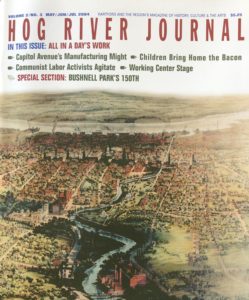(c) Connecticut Explored Inc. May/Jun/Jul 2004
Subscribe/Buy the Issue!
My husband says my work experience is incomplete because I never waited tables. He considers his stints as waiter, short-order cook, and bartender as important learning experiences in what we now call multitasking and serving the customer. A seminal work experience I did have was as a scab in a ball-bearing factory one summer. I was a teenager and did not know what being a scab meant. My parents discouraged me but let me follow my friends. I thought we were just helping out their dads, and the people who screamed at us as we drove through the picket line were curiosities observed with the near-complete detachment only a teenager could affect. The work paid incredibly well (at least to someone with no bills to pay)—and was incredibly boring. Though part of me wondered why the strikers wanted these jobs, they clearly wanted them badly. The experience gave me an appreciation for the rigors of factory work and was my introduction to organized labor. Suffice it to say, I am not proud of having crossed a picket line.
In this issue we look at people’s experiences of work and labor in the past. We look at child labor, factory and agricultural work, and even slave labor. How our working lives have changed over time! In the agrarian economy, work was centered around home and farm. With the industrial revolution, workers left home for factory jobs nearby. Public transportation and the automobile brought the phenomenon of commuting to work. Today, there are people who commute by airplane to jobs in other countries.
Then there are those, like me, who are back to home-based labor, courtesy of the home office outfitted with computer and Internet connection. When Susan Christensen of Fox 61 News offered to do a story on HOG RIVER JOURNAL last May, she suggested they come film the staff at our offices, putting the magazine together. But HOG RIVER JOURNAL has no offices, and the ability to function without the expense of a physical location is, in part, what makes a publication like HOG RIVER JOURNAL possible. So how does the work get done? Except for our freelance editor and graphic designer, the HRJ “staff” (listed on page 10) do this job “on the side,” pro bono. Once a month, after a long day of work at our regular jobs, we meet at one home or another to plan the content of upcoming issues, review layouts, and discuss ongoing operational issues. Between meetings, business is conducted by phone and e-mail. All articles are submitted, edited, and reviewed by e-mail, and the magazine is sent to the printer electronically. Initially I felt odd about our part-time status and the fact that we existed in print and on the Web but lacked that fancy corner office (never mind a conference room). I’ve since found our situation is not at all unusual. There is a whole world of people combining a pastiche of jobs and identities, conducted from all kinds of locations, including home offices and Web sites.
So why do we take on this second job of publishing HOG RIVER JOURNAL? Most definitely for the best reason: it’s a labor of love.
Explore!
Read all of the stories from Vol 2/No 3 May/Jun/July 2004
Read all of our stories about Labor History on our TOPICS page

